27 January 2011
Courtesy Louise Stickland 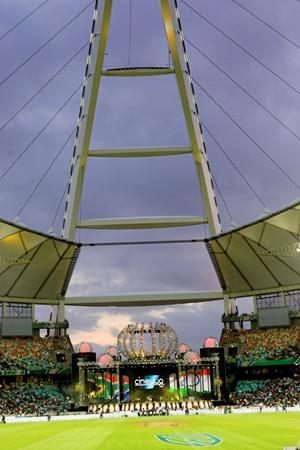 Over 40,000 excited cricket fans packed the Moses Mabhida Stadium in Durban, South Africa, to see India clinch victory over the Proteas (South Africa) in Sunday’s Standard Bank International Pro20 international cricket tournament, in the process, making history as the biggest crowd ever to watch a cricket match on the African continent.
Over 40,000 excited cricket fans packed the Moses Mabhida Stadium in Durban, South Africa, to see India clinch victory over the Proteas (South Africa) in Sunday’s Standard Bank International Pro20 international cricket tournament, in the process, making history as the biggest crowd ever to watch a cricket match on the African continent.
A knife edge finish fuelled the amazing vibe, but theoretically it would have been a win-win scenario whichever team had triumphed for SA’s substantial Indian community in Durban, who needed no extra reasons to party as they also experienced history with the ‘New Age Friendship’ Celebration Concert.
This visual extravaganza of spectacular proportions was the first ever such post cricket match entertainment event, with the additional resonance of celebrating the 150th anniversary of the arrival of Indians in Africa.
The Concert was conceived and produced by Katija Ali of AA Media for match organisers Cricket South Africa (CSA). Ali asked Gearhouse South Africa – with whom she has worked on many previous projects – to deliver a production design and all the required technical elements to make the show – starring Indian megastar Shah Rukh Khan and a host of other top talent from India and South Africa – something very special.
The stage, set, visual and lighting design was created by Gearhouse’s Tim Dunn – a carefully crafted and somewhat fabulous fusion of classic architectural shapes and cultural symbols from India and Africa.
The production was ensconced into the bleachers at the south end of the stadium, it’s striking form combined metalwork, scenic texturing and LED screen surfaces complementing the magnificent curvature of the 350 metre long, 105-metre high arch that defines the skyline of Durban’s iconic visual masterpiece.
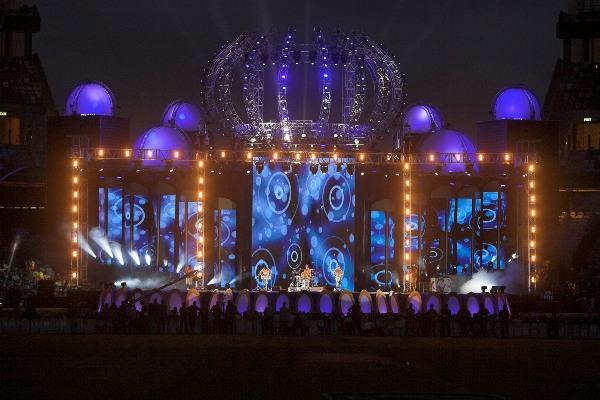 Dunn’s imagineering skills were tested with many curve balls!
Dunn’s imagineering skills were tested with many curve balls!
The stage structure’s footprint had to involve the removal of an absolute minimum of seats; the design had to be roof-less to preserve maximum sight lines from all around the stadium – amid the KwaZulu Natal rainy season where the meteorology was at best unpredictable and at worst schizophrenic; the colour of the stage and set cladding had to ensure the cricket ball was clearly visible during the match, and the whole operation had to be installed and ready in under a week.
Additional pressures included the concert being televised live worldwide on ESPN, opening up the potential audience to several million.
Gearhouse SA is used to working to tight deadlines and under perverse and difficult environmental conditions. The experience, resources and synergies of several of the company’s departments – Rigging, Structures, Audio, Lighting, Media, together with the services of sister companies SDS (set building) and LEDVision (LED screen) – were energised to make this one rock in true Bollywood style.
A strong and committed team of over 50 crew from the company’s Johannesburg, Durban and Cape Town branches was assembled to work a gruelling schedule and deliver an amazing result, project managed by Michael Lewis and Eyal Yehezkely.
Integrally involved with the advance and on site co-ordination was Gearhouse’s Durban branch operations manager, Stuart Andrews, who dealt with much of the mountain of necessary groundwork, protocol and administration needed to stage a gig of this scale in the venue. This included regular meetings with the various stadium departments, technicians and engineers, plus local authority departments and copious cross-liaison with both end clients – AA Media and CSA – and Tim Dunn as the design evolved.
Advance work started on the project in September, ramping up steadily and then intensely as the show date approached.
Amassing experienced and dedicated teams from each department was one of the keys to the success of realising such an ambitious technical project, which was severely interrupted and hampered by long periods of torrential rain during the build.
Also at the essence was keeping the complex network of communications between all involved – from the crews to the clients – fluid, face-to-face and transparent.
Others central to the production loop were the show creative and artist liaison teams from Wizcraft and Cineyug, both based in Mumbai, who lined up the performers – also starring Anil Kapoor, Shahid Kapoor and Priyanka Chopra from India together with Locnville, Drum Cafe from South Africa for the 3 hours of action packed live entertainment, which also included a speech by South African President, Jacob Zuma.
On site, as with all large Gearhouse projects, a great camaraderie and spirit fuelled everyone’s energy and determination to get the show on in the face of all the prevailing challenges.
Structures, Set & Rigging
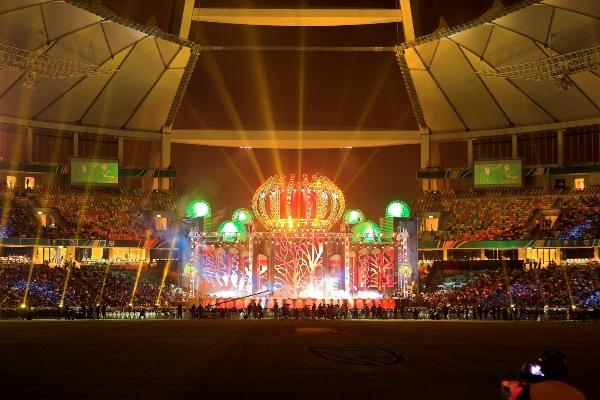 The first departments on site were Gearhouse Structures overseen by Attie van Staden and the team from SDS (Sets, Drapes, Screens) led by Pieter Joubert and André Matthysen who all collaborated closely to build the foundations.
The first departments on site were Gearhouse Structures overseen by Attie van Staden and the team from SDS (Sets, Drapes, Screens) led by Pieter Joubert and André Matthysen who all collaborated closely to build the foundations.
A large scaffolding ‘back wall’ was constructed to facilitate installation of the ‘Calabash’, a traditional African pot shaped trussing construction anchored to two 9 metre diameter circles top and bottom with 16 gently curved 8 metre ribs, which crowned Dunn’s stage set.
Ninety per cent of the Calabash was built on the ground. This was then craned into place by a 60 tonne crane which landed it on the 20 metre high (from the ground at the front, 10 metres off the stepped bleacher deck behind) back wall. The final 4 ribs were added once it was in situ.
The main scaffolding superstructure accommodated further set elements and the PA wings. Flanking the Calabash were 6 variously sized ‘minaret’ style domes – made from white fabric stretched over arched mini-trussing – rigged on platforms along the 2 side wings of the scaff structure at different elevations.
There was a large LED centre screen onstage, with 5 chevron shaped scenic LED columns either side, with the clean, precise lines of the LED bringing a dynamic contrast to the curves above.
SDS produced a series of grey corrugated PVC printed drops to fill in all the gaps concealing all traces of scaffolding, together with slick grey headers to cap the LED columns, so apart from the Calabash and the front legs of the ground support system (see below), no raw metalwork was visible. The PA wings were finished in gauze scrims sporting the CSA logo.
The structure, fully loaded with all the technical equipment – including, LED, lights and PA – weighed about 150 tonnes, requiring some careful loading calculations before receiving the green light from the stadium’s structural engineers to build on the seating stands.
The stage measured 26 metres wide and 12 deep, with three shallow curved thrusts at the front, continuing the arc theme of the higher elements. The scaffolding superstructure was built by GH Structures, then clad and dressed in wood by SDS, and diligently hand painted in black with 3 white CSA logos on each thrust area. This worked brilliantly as ambient branding for the overhead camera shots. Distinctive floors are a frequent feature of Dunn’s designs.
Twenty-five translucent oval ‘shields’ were attached to the front of the stage apron and back lit, a contemporary take on Zulu armoury, providing a flourishing finishing detail to the set’s visual coherence from the lowest to the highest levels.
The GH Rigging department was led by Roy Wood from the Durban office, with all the kit supplied from Johannesburg. Like everyone, they battled with the rain and the time it cost, working long and arduous days. Their remit mostly involved flying and then anchoring elements in place, like the main screen which was landed on the deck with 7 x 2-tonne motors that were then removed, leaving the LEDVision crew to install the last 2 rows of panelling by hand as the full height of the screen could not be flown due to the height restrictions.
They built an 8 leg ground support system onstage, covering the upstage two thirds of the performance space to give rear, side and mid-stage lighting positions. A sub hung mid truss flown off this had to be lowered during the match allowing a clear trajectory for three camera positions which were specially created by Dunn on the top deck, just in front of the Calabash.
The PA stayed hanging for the show – a quick and straightforward task, and the side fills were sub hung from the ground support system.
Lighting
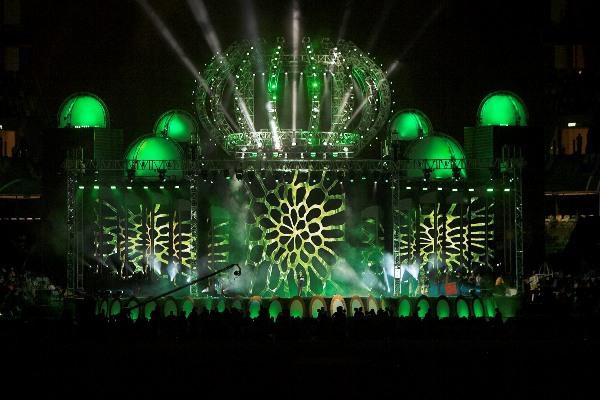 With the front legs of the ground support system a good 3 metres upstage of the edge of the central thrust, the only downstage lighting positions were 12 follow spots, 6 per side on 2 platforms (6 x Gladiators and 6 x Supertroupers) in the stadium at 90 degrees to the stage. This presented a challenge as some of the acts featured large dance contingents, however, Dunn was replete with multiple options for back, side and mid stage plus set and scenic lighting fixtures.
With the front legs of the ground support system a good 3 metres upstage of the edge of the central thrust, the only downstage lighting positions were 12 follow spots, 6 per side on 2 platforms (6 x Gladiators and 6 x Supertroupers) in the stadium at 90 degrees to the stage. This presented a challenge as some of the acts featured large dance contingents, however, Dunn was replete with multiple options for back, side and mid stage plus set and scenic lighting fixtures.
Crowning the top circle of the Calabash were 10 Robe ColorSpot 2500E ATs, ideal for aerial effects. The ribs were all toned by an LED PAR top and bottom, and on the 10 front facing ribs were 12 x i-Pix Satellites used highly effectively for lively ‘sparkling’ chases. In the centre of the top deck of the Calabash were 7 x Panther 5K xenon searchlights for mega bright aerial and back beam effects into the night sky.
Along the front edge of the structure’s top deck were 8 Robe ColorSpot 2500E ATs and 6 Robe REDWash 3●192s, while the minarets were internally lit using 12 i-Pix BB4s a side.
The ground support onstage had a widthways span of 30 metres with 2 levels of trim at 9 and 10 metres, diagonally slung truss upstage and the mid truss that was moved in during the match for the 3 cameras. On the ground support were another 20 REDWashes, 6 Robe ColorSpot 2500s and 24 x ColorWash 2500s. These were all used for front and back stage washing, upstage key lighting and loads of fabulous, rich and powerful beamy looks.
Highlighting the definition and geometry of the front legs and forward trusses of the ground support were 48 x 2-cell Moles.
At floor level, under the side screen columns and PA wings were 24 Robe ROBIN 300 Spots, 12 a side, together with 4 ROBIN 300 Washes a side shooting up the scrims and illuminating the logo.
Sixteen ROBIN 300 Washes were positioned along the sides of the stage in the ‘shin buster’ position, used for cross stage and low level modelling for the dancers. Dunn specifically chose Robe moving lights because of their propensity for withstanding rain and damp conditions, which proved a wise decision!
Either side of the stage at floor level radiating out around the field of play were 16 x Panther 5Ks, used for super-sized aerial effects across the front section of the pitch, juxtaposed with the floor lighting on the stage. Complementing these and tying them into a sumptuous array of ‘stadium looks’ were 36 Panther 2K xenons, rigged all around the front wall of the highest level of bleacher seating via bespoke brackets.
The 25 shields along the front of the stage were each up-lit with a BB4 unit.
Dunn explained that the lateral aim was to give the stage scale, presence and a defining geometry amidst the stadium’s visually commanding environment; to integrate lighting and visuals seamlessly with the set, as well as working independently to cover the performance space and diffuse the onstage energy into the audience. The show had to work for TV and live audiences and contain enough much anticipated big stadium lighting WOW factors throughout, whilst ensuring that all – from those sitting parallel to the stage to the Presidential Box to the top of the bleachers at FOH – enjoyed a great show experience.
He programmed and ran the show on a grandMA full size console, with Hugh Turner calling follow spots.
Pure experience, basic imaginative instincts and an in-depth technical understanding of the kit’s capabilities were all invaluable tools enabling Dunn to produce an epic show with all the glitz and razzamatazz of Bollywood combined with all the dynamics required for a high profile live telecast in such a short timeframe.
Mercifully, the Friday before Sunday’s show was the first dry, sunny day of the week, but this left only 2 nights for some intense programming, with limited stage time to themselves and darkness ending abruptly at 4 a.m. with the unfailingly cheerful twittering of birdsong!
Video
A second grandMA full size at front of house was used by Gearhouse Media’s Marcel Wijnberger, driving 3 x MA VPUs sending custom created ambient content plus that supplied by some artists to the onstage LED screens.
A full Barco Encore screen management system, operated by Luigi Cosani, handled video distribution to all the LED surfaces, which were made up from 224 panels of Lighthouse R16, configured as a single image to run across all 3 processors.
He also received a TX feed from the Supersport HD OB truck, which was output to 2 x 16 by 9 ft side screens either side of stage at the back of the second level seating, each fed by a Christie 18K projector.
Wijnberger also designed and installed the fibre system running data for lighting and video from the stage, 280 metres to the front of house position. Two lines (master and backup) were run via two MA NPUs backstage at the dimmer position.
Audio
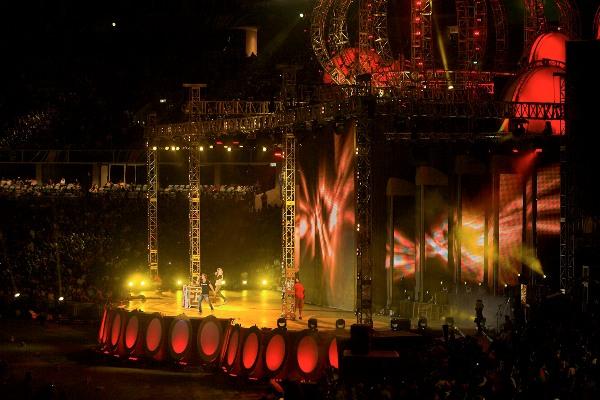 Sound was a mix of the L-Acoustics racks-and-stacks from Gearhouse Audio and the stadium’s house JBL VerTec system, for which FOH and monitor engineer Cyril “Rasta” Sewela and his team of 4 liaised with house sound designer Alex Sanfilippo .
Sound was a mix of the L-Acoustics racks-and-stacks from Gearhouse Audio and the stadium’s house JBL VerTec system, for which FOH and monitor engineer Cyril “Rasta” Sewela and his team of 4 liaised with house sound designer Alex Sanfilippo .
The stage hangs were 2 arrays of 12 x L-Acoustics VDOSC speakers a side, complete with 16 SB 28 subs in total, plus side hangs of 6 Kudos a side, all powered by LA8 amplifiers. The stadium system consists of 12 stacks of 9 x VT4888WRX, spaced equidistantly below two elegant steel catwalks running along either side of the stadium below the roof line. The optimum goal was to ensure a clear, even coverage throughout the space, and to tweak the house system to sound like the output was coming from stage.
Sewela tuned the system, and the show – including monitors – was mixed via a Yamaha PM5D, its small footprint also ideal for the situation, tucked unobtrusively in the front rows just above pitch level, about 30 degrees around on stage left.
They made use of all the console’s onboard effects, and Dolby Lake processing for system EQ. He also found that his experience of working on the recent AR Rahman concert – the first full production music show to visit the venue – and a couple of other heritage shows in there was extremely useful.
The side fills were dv-DOSC, three speakers a side with a sub, and L-Acoustics 115s monitors were provided for percussion collective First Project, who opened the show.
For the seated VIP area directly in front of the stage, 2 stacks of 3 x Kudos were positioned stage left and right at pitch level, working together with dv-DOSC front fills on the stage.
A full selection of radio mics were part of the audio package, including locally made Ocalex headset mics, plus Shure headsets and hand-helds along with a Sennheiser G3 IEM system.
The concert was a massive success with Jacob Zuma even suggesting that it could become an annual event. For Gearhouse, it was the conclusion of another totally unique, large production to add to their impressive list of world class designed and delivered events, as much as it was a ‘celebration’ of incredible teamwork, knowledge, foresight and hard work.




